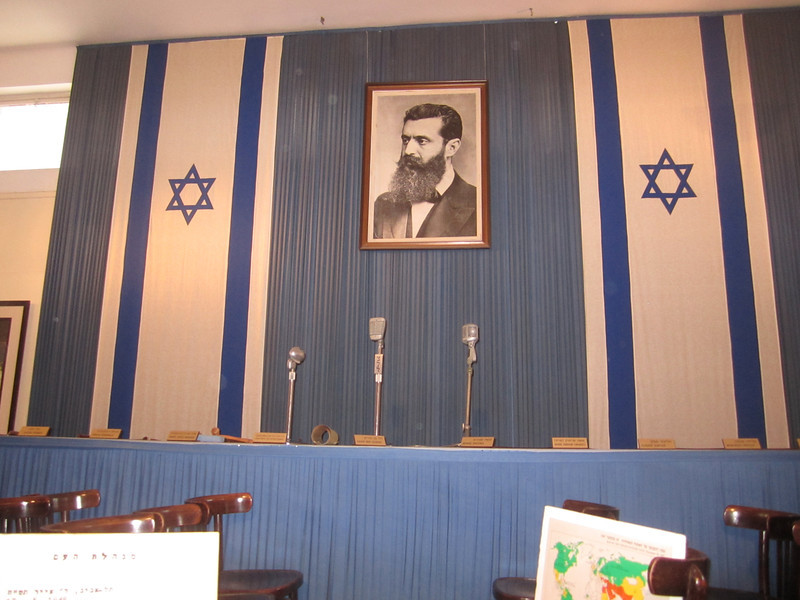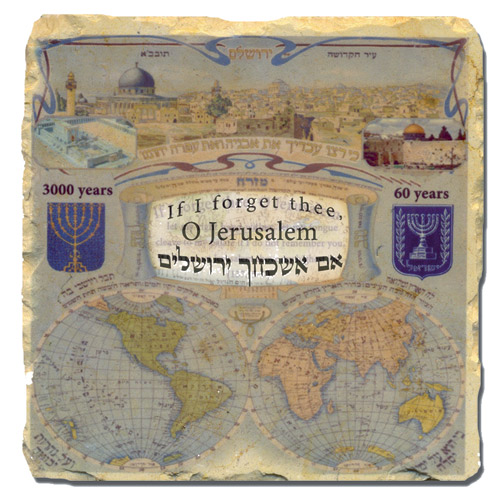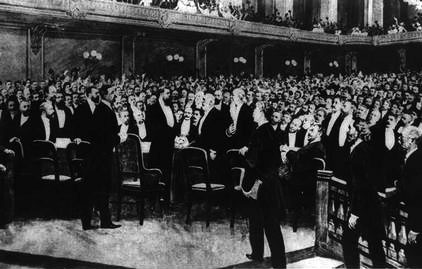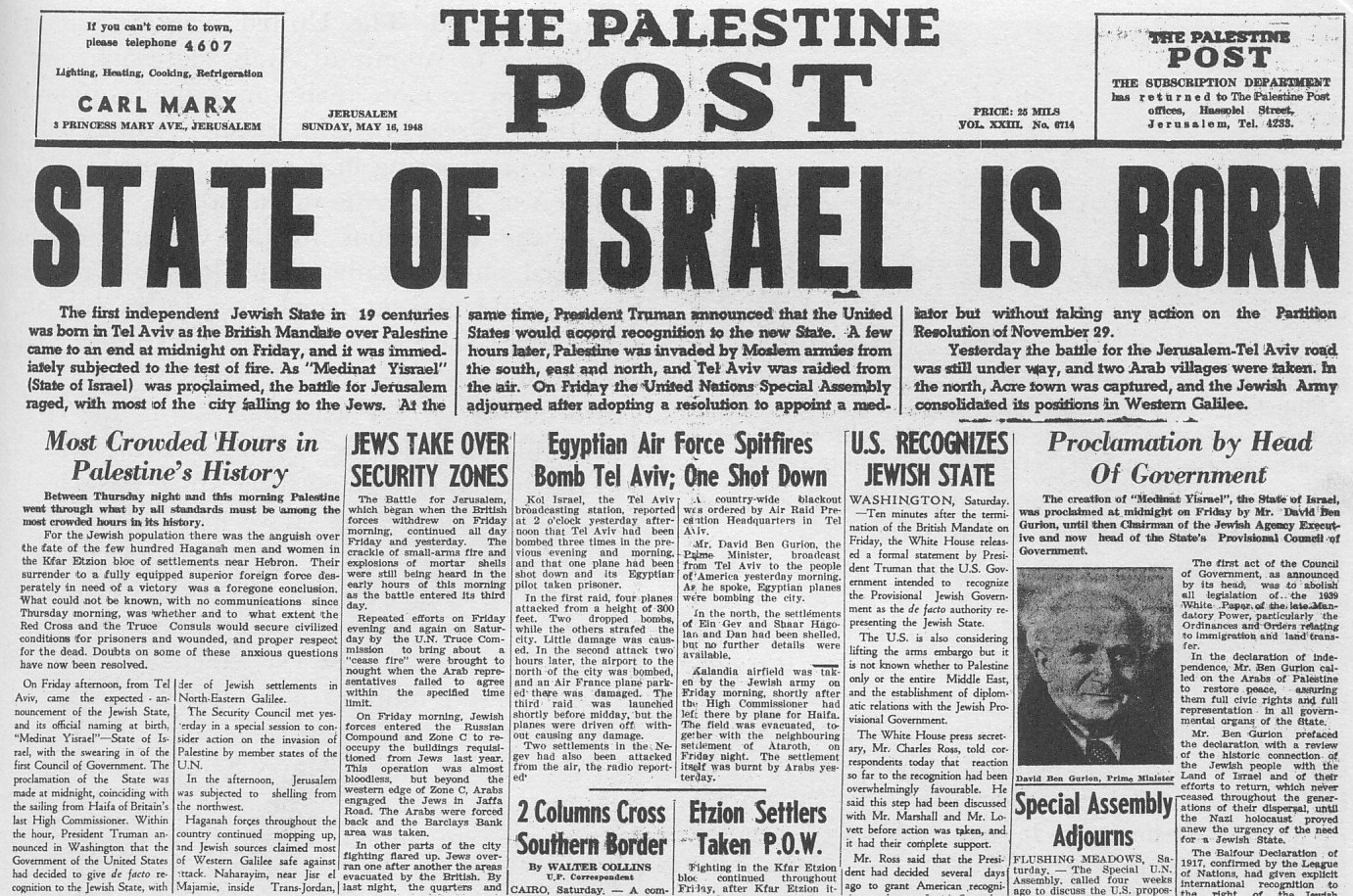Today is Yom Ha’Atzmaut (יום העצמאות), Israel’s 66th Independence Day, which is celebrated based on the Jewish calendar (5th of Iyar) rather than the common calendar date of May 14th, 1948.

Israel’s declaration of independence took place at Independence Hall in Tel Aviv. It has been restored into a museum, and the most surprising thing for me, when I visited it, was how small it is.
Most people who have seen the famous video of Ben Gurion reading the declaration get the impression that the hall is large and filled with thousands of people:
but in fact it is quite small, fitting at most a couple of hundred very crowded people. Still, it’s very thrilling to visit the exact spot where the State of Israel was born on a sunny Friday afternoon, and the course of history was changed forever.
The declaration itself is a great document to read. This year, the Conference of Presidents of Major Jewish Organizations has placed full-page ads of the declaration in a number of leading newspapers in order to encourage Americans to read the text, and see for themselves how similar the foundational principles of Israel are to those of America.
I hope you take a few minutes to read the whole thing before we analyze it together. It’s well worth the time. You can also find a text version here.
Analysis of Israel’s Declaration of Independence
The declaration starts with the Bible, but notice that does not invoke any divine religious authority. Rather, it views the Bible, as I have analyzed it in a previous post, as the formative story of the Jewish people. It emphasizes the Bible as the foundational cultural legacy that the Jewish people in the land of Israel gave the world. It also emphasizes the moral laws of the bible as having “universal significance”:
“The Land of Israel was the birthplace of the Jewish people. Here their spiritual, religious and political identity was shaped. Here they first attained to statehood, created cultural values of national and universal significance and gave to the world the eternal Book of Books.”
The declaration condenses the Jewish yearning to return to their homeland throughout their centuries of exile into one powerful paragraph:
“After being forcibly exiled from their land, the people kept faith with it throughout their Dispersion and never ceased to pray and hope for their return to it and for the restoration in it of their political freedom. Impelled by this historic and traditional attachment, Jews strove in every successive generation to re-establish themselves in their ancient homeland.”
The declaration continues to summarize the accomplishments of the pioneers who dried out forsaken swamp-land and made deserts bloom, molding the Jewish people into a coherent nation:
“In recent decades they returned in their masses. Pioneers, defiant returnees, and defenders, they made deserts bloom, revived the Hebrew language, built villages and towns, and created a thriving community controlling its own economy and culture, loving peace but knowing how to defend itself, bringing the blessings of progress to all the country’s inhabitants, and aspiring towards independent nationhood.”
The hour-long movie “The Land of Promise” was produced in 1935 to showcase the miracle of Jews resettling in their land:
The declaration then acknowledges Theodore Herzl as the “spiritual father of the Jewish State” and the First Zionist Congress which was the first time in history that 200 Jewish leaders from 17 countries convened and resolved to “establish a home for the Jewish people in Palestine secured under public law.”
“In the year 5657 (1897), at the summons of the spiritual father of the Jewish State, Theodore Herzl, the First Zionist Congress convened and proclaimed the right of the Jewish people to national rebirth in its own country.”
The next paragraph is the legal foundation of the declaration. It mentions the Balfour Declaration, but more importantly, it mentions the Mandate of the League of Nations:
“This right was recognized in the Balfour Declaration of the 2nd November, 1917, and re-affirmed in the Mandate of the League of Nations which, in particular, gave international sanction to the historic connection between the Jewish people and Eretz-Israel and to the right of the Jewish people to rebuild its National Home.”
This last part about the Mandate of the League of Nations is often played down, but it is, in fact, the legal foundation of the State of Israel. Ben Gurion is referring here to the San Remo Conference which took place after the end of World War I, on April 19, 1920. Here is an important paper by legal scholar Howard Grief explaining it.
The League of Nations issued the Mandate for Palestine, which was granted to the British government for the sole purpose of establishing a Jewish homeland in the Land of Israel. The fact that the Balfour Declaration was included in the Mandate document is what turned that declaration from a mere letter into binding international law.
Fifty-one member countries – the entire League of Nations – unanimously declared on July 24, 1922: “Whereas recognition has been given to the historical connection of the Jewish people with Palestine and to the grounds for reconstituting their national home in that country.”
The United States Congress adopted Joint Congressional Resolution (360) on June 30, 1922 which said: “Resolved by the Senate and House of Representatives of the United States of America in Congress assembled. That the United States of America favors the establishment in Palestine of a national home for the Jewish people, it being clearly understood that nothing shall be done which should prejudice the civil and religious rights of Christian and all other non-Jewish communities in Palestine, and that the holy places and religious buildings and sites in Palestine shall be adequately protected.”
In the next two paragraphs, the declaration addresses the Holocaust:
“The catastrophe which recently befell the Jewish people – the massacre of millions of Jews in Europe – was another clear demonstration of the urgency of solving the problem of its homelessness by re-establishing in Eretz-Israel the Jewish State, which would open the gates of the homeland wide to every Jew and confer upon the Jewish people the status of a fully privileged member of the community of nations.
Survivors of the Nazi holocaust in Europe, as well as Jews from other parts of the world, continued to migrate to Eretz-Israel, undaunted by difficulties, restrictions and dangers, and never ceased to assert their right to a life of dignity, freedom and honest toil in their national homeland.”
The next 3 paragraphs lead from the Holocaust to the formation of the United Nations and the acceptance of Israel as a member in the UN and the famous vote on “the right of the Jewish people to establish their State”:
“In the Second World War, the Jewish community of this country contributed its full share to the struggle of the freedom- and peace-loving nations against the forces of Nazi wickedness and, by the blood of its soldiers and its war effort, gained the right to be reckoned among the peoples who founded the United Nations.
On the 29th November, 1947, the United Nations General Assembly passed a resolution calling for the establishment of a Jewish State in Eretz-Israel; the General Assembly required the inhabitants of Eretz-Israel to take such steps as were necessary on their part for the implementation of that resolution. This recognition by the United Nations of the right of the Jewish people to establish their State is irrevocable.
This right is the natural right of the Jewish people to be masters of their own fate, like all other nations, in their own sovereign State.”
The next two paragraphs are the heart of the declaration:
“Accordingly we, members of the People’s Council, representatives of the Jewish Community of Eretz-Israel and of the Zionist Movement, are here assembled on the day of the termination of the British Mandate over Eretz-Israel and, by virtue of our natural and historic right and on the strength of the resolution of the United Nations General Assembly, hereby declare the establishment of a Jewish state in Eretz-Israel, to be known as the State of Israel.
We declare that, with effect from the moment of the termination of the Mandate being tonight, the eve of Sabbath, the 6th Iyar, 5708 (15th May, 1948), until the establishment of the elected, regular authorities of the State in accordance with the Constitution which shall be adopted by the Elected Constituent Assembly not later than the 1st October 1948, the People’s Council shall act as a Provisional Council of State, and its executive organ, the People’s Administration, shall be the Provisional Government of the Jewish State, to be called Israel.”
Promise For The Future
Up to this point, the document is a build-up to the declaration of independence in the previous two paragraphs, but from this point on, it switches to forward-looking statements. Since Israel has no formal constitution, the following paragraph is often seen by many as the defining constitutional foundation of Israel:
“The State of Israel will be:
open for Jewish immigration and for the Ingathering of the Exiles;
it will foster the development of the country for the benefit of all its inhabitants;
it will be based on freedom, justice and peace as envisaged by the prophets of Israel;
it will ensure complete equality of social and political rights to all its inhabitants irrespective of religion, race or sex;
it will guarantee freedom of religion, conscience, language, education and culture;
it will safeguard the Holy Places of all religions;
and it will be faithful to the principles of the Charter of the United Nations.”
The following key statement is the official acceptance of Israel of the 1947 UN Partition Plan which partitions the land into a Jewish State and an Arab State. So, Israel’s agreement to a two-state solution was built right into the declaration!
“The State of Israel is prepared to cooperate with the agencies and representatives of the United Nations in implementing the resolution of the General Assembly of the 29th November, 1947, and will take steps to bring about the economic union of the whole of Eretz-Israel.”
However, the Arabs rejected the Partition Plan both verbally, and by their deeds: the next morning 5 Arab armies invaded the land of Israel, thereby setting in motion the War of Independence.
Still, at 4pm on Friday, Ben Gurion did not know that 5 Arab armies were going to attack the next day, on Saturday morning, and he extended his hand in peace, as Israel continues to do to this day:
“We appeal to the United Nations to assist the Jewish people in the building-up of its State and to receive the State of Israel into the community of nations.
We appeal – in the very midst of the onslaught launched against us now for months – to the Arab inhabitants of the State of Israel to preserve peace and participate in the upbuilding of the State on the basis of full and equal citizenship and due representation in all its provisional and permanent institutions.
We extend our hand to all neighboring states and their peoples in an offer of peace and good neighborliness, and appeal to them to establish bonds of cooperation and mutual help with the sovereign Jewish people settled in its own land. The State of Israel is prepared to do its share in a common effort for the advancement of the entire Middle East.

We appeal to the Jewish people throughout the Diaspora to rally round the Jews of Eretz-Israel in the tasks of immigration and upbuilding and to stand by them in the great struggle for the realization of the age-old dream – the redemption of Israel.
Placing our trust in the Almighty, we affix our signatures to this proclamation at this session of the provisional Council of State, on the soil of the Homeland, in the city of Tel-Aviv, on this Sabbath eve, the 5th day of Iyar, 5708 (14th May, 1948).”
Happy Yom Ha’Atzmaut!
